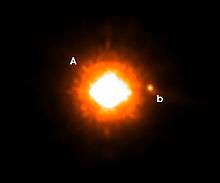GQ Lupi
| Observation data Epoch J2000.0 Equinox J2000.0 (ICRS) | |
|---|---|
| Constellation | Lupus |
| Right ascension | 15h 49m 12.144s[1] |
| Declination | −35° 39′ 03.95″[1] |
| Apparent magnitude (V) | 11.40[1] |
| Characteristics | |
| Spectral type | K7V[1] |
| B−V color index | 0.96[1] |
| Variable type | T Tauri variable[2] |
| Astrometry | |
| Proper motion (μ) | RA: −27[1] mas/yr Dec.: −14[1] mas/yr |
| Parallax (π) | 6.4 ± 1.9[2] mas |
| Distance | approx. 500 ly (approx. 160 pc) |
| Absolute magnitude (MV) | ~5[3] |
| Details | |
| Mass | 0.7[4] M☉ |
| Age | <2 million[4] years |
| Other designations | |
| Database references | |
| SIMBAD | data |
GQ Lupi is a T Tauri variable star approximately 500 light-years away in the constellation of Lupus.[2] The star is young and has about 70% of the Sun's mass.[4]
Possible planetary system

VLT NACO image, taken in the Ks-band, of GQ Lupi. The feeble point of light to the right of the star is the newly found cold companion. It is 250 times fainter than the star itself and it located 0.73 arc second west. At the distance of GQ Lupi, this corresponds to a distance of roughly 100 AU. North is up and East is to the left.
In 2005, Ralph Neuhäuser and his colleagues reported a substellar object, GQ Lupi b, orbiting the star. Along with 2M1207b, this was one of the first extrasolar planet candidates to be directly imaged. The image was made with the VLT telescope at Paranal Observatory, Chile, on June 25, 2004. Depending on its mass and the definition of a planet, GQ Lupi b may or may not be considered a planet.[5] As of 2006, the International Astronomical Union Working Group on Extrasolar Planets described GQ Lupi b as a "possible planetary-mass companion to a young star."[6]
| Companion | Mass | Observed separation (AU) |
| b | 1–36[2][7] MJ | 103 ± 37[7] |
References
- 1 2 3 4 5 6 7 8 "V* GQ Lup". SIMBAD. Centre de données astronomiques de Strasbourg. Retrieved June 13, 2008.
- 1 2 3 4 Astrometric and photometric monitoring of GQ Lupi and its sub-stellar companion, Ralph Neuhaeuser, Markus Mugrauer, Andreas Seifahrt, Tobias Schmidt, and Nikolaus Vogt, Astronomy and Astrophysics 484, #1 (2008), pp. 281–291. doi:10.1051/0004-6361:20078493. Bibcode: 2008A&A...484..281N
- ↑ From parallax and apparent magnitude.
- 1 2 3 First image of exoplanet orbiting Sun-like star, Kelly Young, April 4, 2005, NewScientist.com news service. Accessed on line June 13, 2008.
- ↑ Is this a Brown Dwarf or an Exoplanet? New Young Sub-stellar Companion Imaged with the VLT Archived 2008-05-07 at the Wayback Machine., ESO Press Release 09/05, April 7, 2005. Accessed on line June 13, 2008.
- ↑ Lists of Extrasolar Planets Archived 2013-10-29 at the Wayback Machine., IAU Working Group on Extrasolar Planets, August 28, 2006. Accessed on line June 13, 2008.
- 1 2 Planet : GQ Lup b, Extrasolar Planets Encyclopaedia. Accessed on line June 13, 2008
External links
- The low-mass companion of GQ Lup, E.W. Guenther, R. Neuhaeuser, G. Wuchterl, M. Mugrauer, A. Bedalov, and P.H. Hauschildt, Astronomische Nachrichten 326, #10 (December 2005), pp. 958–963. doi:10.1002/asna.200510461. Bibcode: 2005AN....326..958G
- R. Neuhaeuser (2005). "Homogeneous comparison of directly detected planet candidates: GQ Lup, 2M1207, AB Pic". arXiv:astro-ph/0509906v1.
- "V* GQ Lup". SIMBAD. Retrieved 2008-06-13.
- Young, Kelly (2005-04-04). "First image of exoplanet orbiting Sun-like star". New Scientist. Retrieved 2008-06-09.
- "Telescopes see 'distant planet'". BBC News. 2005-04-04. Retrieved 2008-06-09.
- Britt, Robert Roy (2005-04-30). "Fresh Debate over First Photo of Extrasolar Planet". SPACE.com. Retrieved 2008-06-09.
This article is issued from
Wikipedia.
The text is licensed under Creative Commons - Attribution - Sharealike.
Additional terms may apply for the media files.